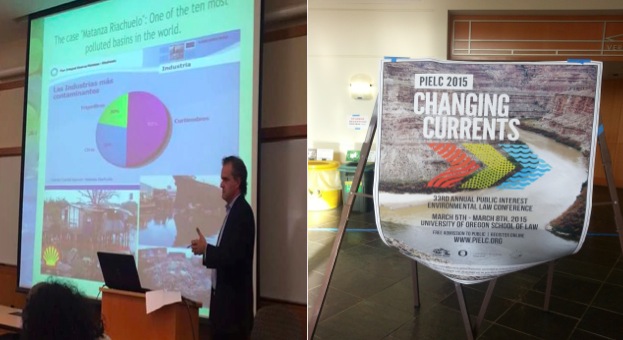Esta entrada también está disponible en: Spanish
March 2015 – Eugene, Oregon
The Public Interest Environmental Law Conference (PIELC) is a premier annual gathering for environmentalists worldwide, and is distinguished as the oldest and largest of its kind. The PIELC historically unites more than 3,000 activists, attorneys, students, scientists, and concerned citizens from over 50 countries around the globe to share their experience and expertise. The conference is organized by the University of Oregon, School of Law.
The four-day Conference in Eugene, Oregon, includes over 125 panels, workshops, and multi-media presentations addressing a broad spectrum of environmental law and advocacy. Topics include: forest protection and ecological restoration, grazing and mining reform, labor and human rights, air and water pollution, Native American treaty rights, globalization and “free” trade, environmental justice, corporate responsibility, marine wilderness, international environmental law, water rights and dam removal, oil and gas litigation, genetic engineering, and urban growth.
Each day of the conference culminates with keynote presentations from preeminent activists, scientists, politicians, philosophers, and authors. Past keynote speakers include Robert Kennedy, Ralph Nader, David Brower, Terry Tempest Williams, Ward Churchill, Vandana Shiva, Paul Watson, Winona LaDuke, Gerry Spence, Ramona Africa, Paul Hawken, and several recipients of the international Goldman Environmental Prize.
Juan Miguel Picolotti, legal coordinator of the Center for Human Rights and Environment (CEDHA) participated as a speaker in the PIELC session on “Helping affected communities to gain access to environmental justice”. He presented “The Matanza Riachuelo River” case, reviewing the strengths and weaknesses of the Argentine Supreme Court’s ruling on one of the world’s 10 most polluted basins. In his evaluation of progress since this precedent-setting ruling, he stated: “While the Court issued a landmark judgment from a legal point of view, particularly as it is the first precedent of the Court on environmental remediation, we still have a long way to go in terms of implementation and enforcement of the judgment because despite some advances we have significant setbacks since the ruling”.
For more information:
Juan Miguel Picolotti
Cel: + 54 9 351 642 2654
www.cedha.net
www.pielc.org

